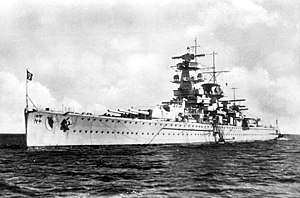SS Clement
TSS Clement, was a British turbine steamship operated by the Booth Steamship Company from 1934 to 1939 until she was intercepted and sunk by the German pocket battleship Admiral Graf Spee off the east coast of Brazil becoming the first victim of Graf Spee's commerce raiding sortie.[2][3][4] [5]
.jpg) SS Clement | |
| History | |
|---|---|
| Name: | SS Clement |
| Owner: | 1934–1939: Booth Steamship Company |
| Operator: | 1934–1939: Booth Steamship Company |
| Port of registry: | Liverpool, United Kingdom[1] |
| Builder: | Cammell Laird |
| Launched: | 11 October 1934 |
| In service: | 1934 |
| Out of service: | 1939 |
| Identification: |
|
| Fate: | Sunk by Panzershiff Admiral Graf Spee |
| General characteristics | |
| Tonnage: | 5,051 gross register tons (GRT) |
| Length: | 405 ft (123.4 m) |
| Beam: | 55 ft 7 in (16.9 m) |
| Depth: | 26 ft (7.9 m) |
| Ice class: | N/A |
| Speed: | 13 knots (24 km/h) |
History
Designed as a cargo and passenger liner, Clement was constructed by the Birkenhead yards of Cammell Laird and commenced service in 1934.[2][3][4]
Following the outbreak of war between Germany and the Allies in September 1939, Adolf Hitler ordered the German Navy to begin commerce raiding against Allied merchant traffic.[2][3][4]
Under the command of Captain Hans Langsdorff, Admiral Graf Spee sailed from Wilhelmshaven on August 21 1939, bound for the South Atlantic. She rendezvoused with her supply ship Altmark on September 1 at a position southwest of the Canary Islands following which she received her orders to commence commerce raiding on September 26, and consequently Langsdorff made towards the coast of South America in order to intercept merchant shipping transporting meat and grain cargoes to the United Kingdom.[2][3][4][5]
The Admiral Graf Spee was under strict instructions to adhere prize rules. This required her to stop and search all intercepted vessels for contraband before sinking them, and to also ensure that the crews of such vessels were safely evacuated prior to any action taking place.[2][3][4][5]
Interception
On September 30 Graf Spee intercepted the Clement at a position 50 nautical miles southeast of Pernambuco. The Graf Spee transmitted to the Clement that under no circumstances should they operate the ship's radio, however the wireless operator ignored the instruction and proceeded to transmit an "RRR" signal ("I am under attack by a raider") as well as giving the position of the Clement in addition to which Captain Harris ensured that important documentation was jettisoned over the side.[2][3][4][5]
As part of the interception, Graf Spee had scrambled her Arado Ar 196 floatplane which proceeded to make several passes of the Clement, shooting at her upper works with its MG 15 machine gun during the course of which the Chief Officer of the Clement received a slight wound to his hand.[2][3][4][5]

In time the crew of the Clement were taken off the ship in the vessel’s four lifeboats. Once in their lifeboats the crew were given a course to steer to the Brazilian port of Maceió, however the Clement's Master, Capt. F.C.P. Harris O.B.E. and Chief Officer were transferred to the Graf Spee following which Capt. Harris was questioned whilst the Chief Officer received treatment for his injury.[2][3][4][5]
Sinking
Following the evacuation of the Clement, Graf Spee proceeded to sink the vessel. However this proved to be a more difficult task than was initially envisaged. Two torpedoes were launched, but failed to find their target. Following this Graf Spee opened fire on the Clement using some of her secondary armament of 15 cm (5.9 in) SK C/28 guns during the course of which she fired 25 rounds. Finally Graf Spee resorted to using some of her main armament of 28 cm (11.0 in) SK C/28 guns and after having expended 11 rounds from her primary guns the Clement finally sank at 16:40hrs.[2][3][4][5]

Aftermath
Having despatched the majority of the crew of the Clement to Maceió, on the evening of September 30 Graf Spee subsequently stopped the Greek tramp steamer Papalemos. At the request of Capt. Langsdorff the Captain of the Papalemos agreed not to send any wireless signals concerning the Clement until they were some 600 nautical miles east from where they were stopped, following which Capt. Harris and his Chief Officer were transferred to the merchantman which continued on its passage allowing Graf Spee to resume its sortie.[2][3][4][5]
The Master of the Papalemos kept his promise until they reached Cape Verde on October 9, and following their arrival in São Vicente Captain Harris and his Chief Officer were released.[5]
Official number and code letters
Official numbers are issued by individual flag states. They should not be confused with IMO ship identification numbers. Clement had the UK Official Number 125122 and used the Code Letters M B B L ![]()
![]()
![]()
![]()
References
- https://www.wrecksite.eu/docBrowser.aspx?KlPtfyiXI254WLLq9HgBQg==
- https://www.wrecksite.eu/wreck.aspx?136723
- https://www.maritimequest.com/warship_directory/germany/pages/cruisers/admiral_graf_spee_ships_history.htm
- https://freepages.rootsweb.com/~treevecwll/family/spees.htm
- https://books.google.im/books?id=WJtICgAAQBAJ&pg=PA90&lpg=PA90&dq=SS+PAPALEMOS&source=bl&ots=m33v_akl_o&sig=NbtBiyohJwJGa-ZoRmCiZLO2uzE&hl=en&sa=X&ved=2ahUKEwiRvK_4gcjfAhVKEVAKHfRWAE4Q6AEwAnoECAcQAQ#v=onepage&q=SS%20PAPALEMOS&f=false